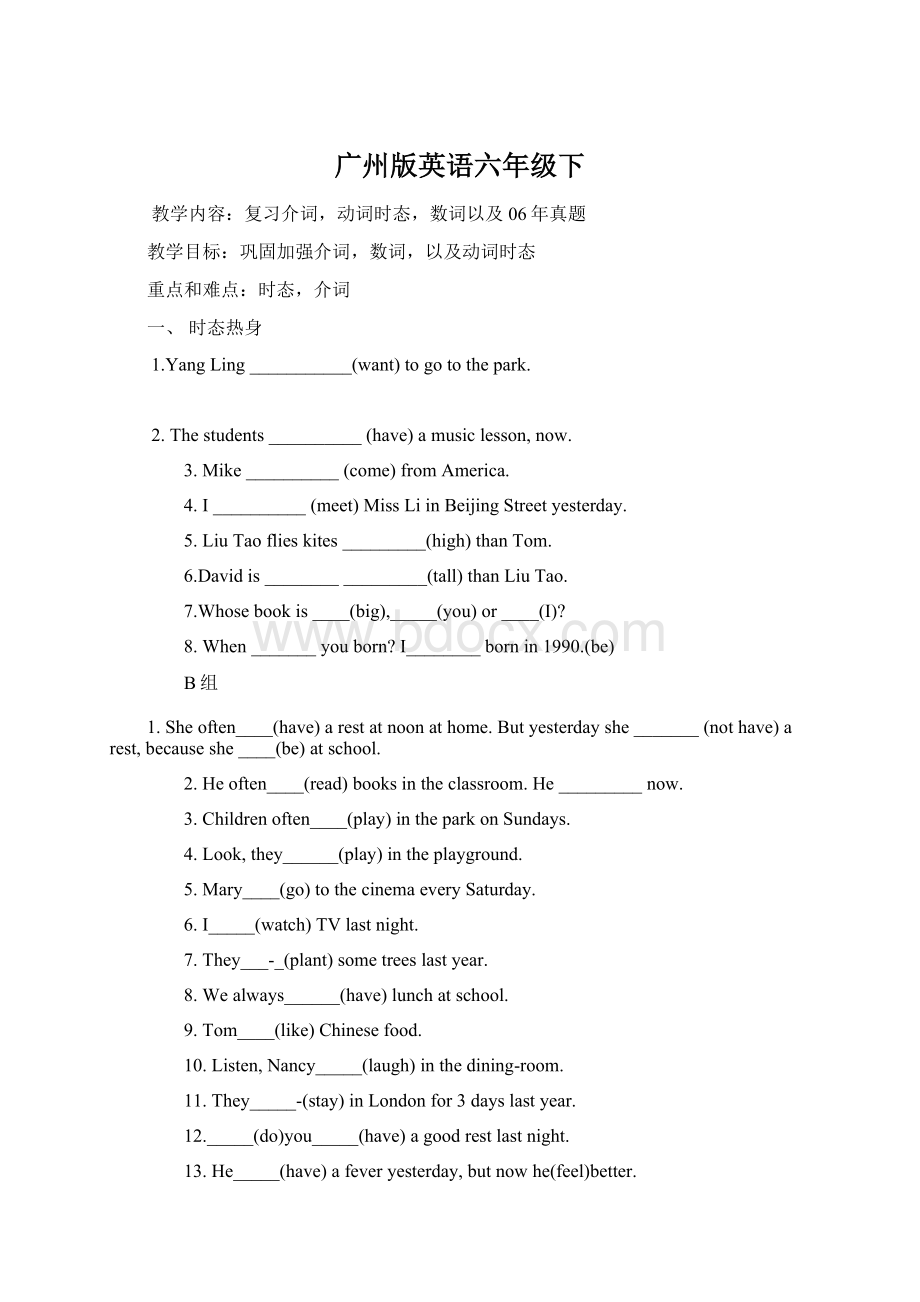广州版英语六年级下文档格式.docx
《广州版英语六年级下文档格式.docx》由会员分享,可在线阅读,更多相关《广州版英语六年级下文档格式.docx(23页珍藏版)》请在冰豆网上搜索。

16.I(be)_______astudentin1976.
17.He(clean)_____---ourclassroomyesterday.
18.Mymother(be)________aworker.
19.They(do)_______theirhomeworkintheclassroomnow.
20.Milan(play)________thepianoeveryevening.
过去时练习
1.一般过去时表示过去某个时间发生的动作或存在的状态,常和表示过去的时间状语连用。
一般过去时也表示过去经常或反复发生的动作感谢。
2.Be动词在一般过去时中的变化:
⑴am和is在一般过去时中变为was。
(wasnot=wasn’t)
⑵are在一般过去时中变为were。
(werenot=weren’t)
⑶带有was或were的句子,其否定、疑问的变化和is,am,are一样,即否定句在was或were后加not,一般疑问句把was或were调到句首。
3.句中没有be动词的一般过去时的句子
否定句:
didn’t+动词原形,如:
Jimdidn’tgohomeyesterday.
一般疑问句:
在句首加did,句子中的动词过去式变回原形。
如:
DidJimgohomeyesterday?
特殊疑问句:
⑴疑问词+did+主语+动词原形?
WhatdidJimdoyesterday?
⑵疑问词当主语时:
疑问词+动词过去式?
Whowenttohomeyesterday?
动词过去式变化规则:
1.一般在动词末尾加-ed,如:
pull-pulled,cook-cooked
2.结尾是e加d,如:
taste-tasted
3.末尾只有一个元音字母和一个辅音字母的重读闭音节,应双写末尾的辅音字母,再加-ed,如:
stop-stopped
4.以“辅音字母+y”结尾的,变y为i,再加-ed,如:
study-studied
过去时练习
写出下列动词的过去式
is\am_________fly_______plant________are________
drink_________play_______go________make________
does_________dance________worry________ask_____
taste_________eat__________draw________put______
throw________kick_________pass_______do________
Be动词的过去时练习
(1)
一、用be动词的适当形式填空
1.I_______atschooljustnow.
2.He________atthecamplastweek.
3.We________studentstwoyearsago.
4.They________onthefarmamomentago.
5.YangLing________elevenyearsoldlastyear.
6.There________anappleontheplateyesterday.
7.There________somemilkinthefridgeonSunday.
8.Themobilephone_______onthesofayesterdayevening.
二、句型转换
1.Itwasexciting.
否定句:
________________________________________________
一般疑问句:
____________________________________________
肯、否定回答:
__________________________________________
2.Allthestudentswereveryexcited.
一般疑问句:
3.Theywereinhispocket.
肯、否定回答:
二、形容词的比较级
1、形容词比较级在句子中的运用:
两个事物或人的比较用比较级,比较级后面一般带有单词than。
比较级前面可以用more,alittle来修饰表示程度。
than后的人称代词用主格(口语中可用宾格)。
2.形容词加er的规则:
⑴一般在词尾加er;
⑵以字母e结尾,加r;
⑶以一个元音字母和一个辅音字母结尾,应双写末尾的辅音字母,再加er;
⑷以"
辅音字母+y"
结尾,先把y变i,再加er。
3.不规则形容词比较级:
good-better,beautiful-morebeautiful
一)、写出下列形容词或副词的比较级
old__________young________tall_______long________
short________strong________big________small_______
fat_________thin__________heavy______light________
nice_________good_________beautiful__________________
low__________high_________slow_______fast________
late__________early_________far_________well_______
二)、根据句意填入单词的正确形式:
1.Mybrotheristwoyears__________(old)thanme.
2.Tomisas________(fat)asJim.
3.Isyoursister__________(young)thanyou?
Yes,sheis.
4.Whois___________(thin),youorHelen?
Helenis.
5.Whosepencil-boxis__________(big),yoursorhers?
Hersis.
6.Mary'
shairisas__________(long)asLucy'
s.
7.Ben______(jump)________(high)thansomeoftheboysinhisclass.
8.________Nancysing__________(well)thanHelen?
Yes,she_____.
9.Fangfangisnotas_________(tall)astheothergirls.
10.Myeyesare__________(big)than________(she)..
11.Whichis___________(heavy),theelephantorthepig?
12.Whogetsup_________(early),TimorTom?
13._____thegirlsgetup_______(early)thantheboys?
No,they______.
14.Jimruns_____(slow).ButBenruns_____(slow).
三、人称代词
数
人称代词
人称
主格
宾格
单
第一人称
我
第二人称
你
第三人称
他
她
它
复
我们
你们
他们
一分钟热身小练
1、_____(我)amateacher.
2、Myfatheristalkingwith______(我)
3、_______areChinese.(我们)
4、Hersisterishelping______.(我们)
5、_____areabeautifulgirl.(你)
6、_____arestudents.(你们)
7、____isacat.(它)
8、______areplayingfootball.(他们)
9、______oftengoestotheparkafterschool.(他)
10、Mydoglikes_____.(她)
物主代词
形容词性物主代词:
我的____你的____他的____她的____它的____
我们的_____你们的_____他们的______
名词性物主代词:
我的_____你的_____他的____她的_____它的_____
我们的_____你们的_____他们的_____
你知道形容词性物主代词和名词性物主代词的区别吗?
1、.形容词性物主代词起形容词的作用,用在名词前。
Thisis_____book.这是我的书。
Welove_____motherland.我们热爱我们的祖国。
2、名词性物主代词起名词的作用。
Lookatthetwopencils.Theredoneis_____andtheblueoneis_____.
看那两支铅笔,红的是你的,蓝的是我的。
Helikes___pen.Hedoesn'
tlike_____.
他喜欢我的钢笔。
不喜欢她的。
3、名词性物主代词=形容词性物主代词+名词
二、根据句意用适当的人称代词、物主代词填空:
1.
Maryworksinabookstore.
likes
workverymuch.
2.
JohnandIareinthesameschool.
gotoschooltogether.
3.
Sheisafriendof
.Wegottoknoweachothertwoyearsago.
4.
Hersistermakesall
owndresses.
5.
Ihavemanyfriends.Someof
aregoodatEnglish.
6.
MayIuse
bike?
isbroken.
7.EverybodyishereexceptAnnand________friendJane.________areinthelibrarynow.
三、选择填空
Who’ssingingoverthere?
—________isSandy’ssister.
A.That
B.It
C.She
D.This
2.
________willspendthesummerholidayinHawaii.
A.She,youandI
B.You,sheandI
C.I,youandshe
D.Her,meandyou
3.
Betweenyouand________,heisnotarealfriend.
A.me
B.I
C.he
D.his
4.
Myuncleboughtanewbikefor________.
A.theirs
B.they
C.me
D.I
5.
MrSmithoftenpraises(表扬)_____inclass.
A.he
B.his
C.I
D.me
6.
Here’sapostcardforyou,Jim!
—Oh,________isfrommyfriend,Mary.
A.he
B.it
C.she
D.it’s
7.
Don’tshake(摇)theyoungtree.___leavesarefallingoff(掉落).Youshouldlookafter__.
A.It,it’s
B.It’s,it
C.Its,it
D.It,it
四、改错
1.Becausehewasillyesterday,sohedidn'
tgotowork.
2.TheSmithshavemovedBeijing.
3.Theboxistooheavyforhimtocarryit.
4.Eachoftheboyshaveapen.
5.NeitherhenoryouisgoodatEnglish
6.Thenumberoftheworkersinthisfactoryareabout5,000.
7.Hello!
Ihaveimportantsomethingtotellyou.
8.Hissonisenougholdtogotoschool.
9.Hereisyoursweater,putawayit
10.Look!
Herethebuscomes
11.Idowellinplayingfootball,_______.(我妹妹也行。
)
A.somysisterdoesB.sodoesmysister
12.LiLeiisreallyafootballfan.---_______.(确实这样.)
A.SoisheB.Soheis
五、数字
从11——19
eleven,twelve,thirteen,fourteen,fifteen,sixteen,seventeen,eighteen,nineteen.
这里除eleven,twelve,thirteen,fifteen,eighteen为特殊形式外,fourteen,sixteen,seventeen,nineteen都是由其个位数形式后添加后缀-teen构成。
C.从20——99
整数几十中除twenty,thirty,forty,fifty,eighty为特殊形式外,sixty,seventy,ninety都是其个位数形式后添加后缀-ty构成。
表示几十几时,在几十和个位基数词形式之间添加连字符“-”,如:
21twenty-one
76seventy-six
D.百位数
个数基数词形式加“hundred”,表示几百,在几十几与百位间加上and.
101ahundredandone
320threehundredandtwenty
648sixhundredandforty-eight
E.千位数以上
从数字的右端向左端数起,每三位数加一个逗号“,”。
从右开始,第一个“,”前的数字后添加thousand,第二个“,”
前面的数字后添加million,第三个“,”前的数字后添加billion。
然后一节一节分别表示,两个逗号之间最大的数为百位数形式。
2,648twothousandsixhundredandforty-eight
16,250,064sixteenmilliontwohundredandfiftythousandsixty-four
5,237,166,234fivebillion,twohundredandthirty-sevenmillion,onehundredandsixty-sixthousand,twohundred,andthirty-four
F.基数词在表示确切的数字时,不能使用百、千、百万、十亿的复数形式;
但是,当基数词表示不确切数字,如成百、成千上万,三三两两时,基数词则以复数形式出现。
1000OneThousand,
10000TenThousand,
100000OneHundredThousand,
1000000OneMillion,
10000000TenMillion,
100000000OneHundred,Million,
一到十的序数词
_______________________________________________
1.一般情况下,将表示年份的四个数字按前后分为两组,每一组的数字都按基数词来读。
例如:
1865年读作eighteensixty-five1998年读作nineteenninety-eight
2.如果前两个数字为非“零”数字,后两位数分别为“零”,则先读出前两位数,然后将后面的两个“零”读为hundred。
1900年读作nineteenhundred1800年读作eighteenhundred
3.第三个数字为“零”(其他数字不是“零”)的年份的读法应当将该“零”读为O〔u〕。
1809年读作eighteenOnine
4.关于千年的一些读法
2000年读作twothousand2008年读作twothousandandeight
1008年读作onethousandandeight(或tenOeight)
5.另外,还有一些非四位数的年份,它们有两种读法:
一种是按照基数词的方法来读,另一种是一个一个数字来读。
531BC读作fivethreeoneBC(或fivehundredandthirty-oneBC)
月份:
January,February,March,April,May,June,July,August,September,October,November,December
星期:
周一:
Monday;
周二:
Tuesday;
周三:
Wednesday;
周四:
Thursday;
周五:
Friday;
周六:
Saturday;
周日:
Sunda